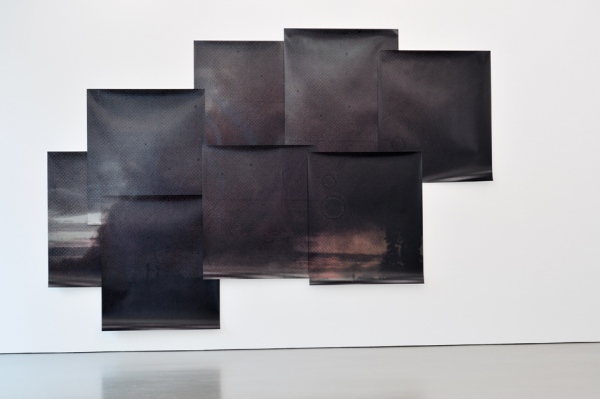-

DISSOLUTION 8 c-prints 145 x 126 cm each, overall dimension 3.26 x 4.85 m, 2010. Photo: Steffen Strassnig
Dissolution (2010) is composed of eight colour prints of 145 by 126 centimetres each, which each present a greatly enlarged section of an existing photograph that Lecomte photographed in segments. The original was not captured completely and in exactly divided segments, but rather with a “free eye”, so to speak, which leads to duplications of the motif as well as to gaps in the overall picture. The photographs of single segments are finally joined together in such a way that representative logic is given its due (the original picture remains readable as such), but because of the shifts and overlaps, however, no coherent whole emerges. Instead, the single picture sections assert their presence with respect to the overall view; “seams” and cracks clearly identify Lecomte’s work as a composite. If one looks closely at the prints, the “breaking up” of the coherence of the image is continued. With the extreme enlargement a print grid becomes visible, which allows the original image to be identified as a reproduction of a photograph. Cyan-coloured, magenta-coloured, yellow and black dots cover the image carrier in different mixtures and densities, manifesting the technical basis of the representation rather than the representation itself.
What it is exactly that the work and its photographic original show is hard to determine: in front of a reddish, overcast sky, a dark cloud is visible, stretching from the lower left edge across the entire picture. Silhouettes of trees and chimneys, maybe the roofs of houses, suggest a residential area in the middle ground. The whole scene is marked by a dark and ominous atmosphere, which is additionally reinforced by the way it is monumentalised and fragmented. Water spots and blemishes that were already part of the original photograph also further suggest that the cloud has contaminated the image carrier itself. Yet the impression of the immediate threat of danger remains diffuse―there are no indications of the time or the place where the photograph was taken, and one can only speculate about the cause of the darkening. In fact, Lecomte’s work is based on a reproduction of what is probably the only colour picture showing the Warsaw Ghetto at the time of the Jewish revolt in April 1943. The “cloud” filling the picture is no inexplicable celestial phenomenon, but rather the smoke rising from the largest National-Socialist internment camp, after German troops set fire to large sections of it.
Consequently, the title Dissolution refers not only to the segmentation of the picture and its break-down into countless dots, but also has a horrifying counterpart in its content in the photographically captured liquidation of the Warsaw Ghetto. Lecomte’s work can be understood on the one hand as an attempt to rob the archive image of its relative harmlessness by presenting it as a monumental piecework. On the other hand, it is a matter of penetrating through the cloud of smoke literally enshrouding what is happening, increasing the visibility of what is depicted and thus revealing what is perhaps a crucial detail. Of course this effort is doomed to fail. Instead of revealing what has not previously been seen, the extreme enlargement withdraws from us what is depicted, disintegrates it into its component parts, and makes the picture appear incomplete and without substance. The boundary, where “the optical added value of visualisation” turns into “white noise” has been crossed.
Manuela Ammer, "Withdrawal Symptoms. On Tatiana Lecomte's Photographic Investigations". In: Tatiana Lecomte, Dissolution, Edition Camera Autria, 2011. Translation: Aileen Dering